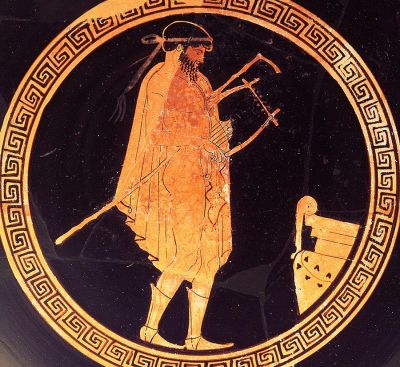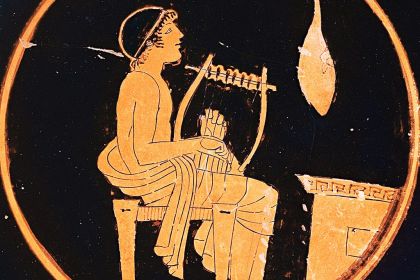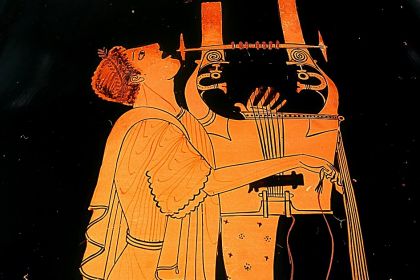Music Theory
6 songs to unpack Ionian mode and the major scale

Terracotta Kylix Attributed to the Pistoxenos Painter
Musical Mode: Ionian Mode
The polyphonic aspects of Western classical music distinguish it from other musical traditions such as Indian Сlassic and Turkish makam, both of which are focused exclusively on a single melodic line usually accompanied by a rhythm section. In contrast, polyphonic music involves the interaction between the horizontal melodic line and vertical chord structures, anticipating the listener's emotional response.
Strictly speaking, the technique for linking melodies with a chord sequence is referred to as homophony, while polyphony implies the interlacing of several melodic lines. As one of the most complex compositional techniques, polyphonic harmony is found primarily in classical works, whereas homophonic textures dominate popular music due to their obvious convenience for songwriters.
In composition, chord progressions that follow the melody are commonly built with the help of seven-note diatonic scales that also make up the corresponding musical modes traditionally named after the geographical regions of Ancient Greece: Ionian, Dorian, Phrygian, Lydian, Mixolydian, Aeolian, and Locrian.
Here are the seven tones of the Ionian scale, the most common major scale in both classical and popular music, often referred to simply as the major scale in musical literature.
C Ionian scale or C major:


The Ionian mode is classified as a major one due to the tonic triad being built on the first scale degree and forming a major chord. Two more major chords in the Ionian mode are rooted in the fourth and fifth degrees, while the minor triads can be built on the second, third, and sixth degrees. For example, C Ionian mode contains the following triads, denoted below in accordance with the rules of harmonic analysis in which major chords are marked with uppercase Roman numerals and minor chords with lowercase Roman numerals: I–C, ii–Dm, iii–Em, IV–F, V–G, vi–Am, vii0–Bdim.
The analysis of C Ionian mode through the Roman numeric system:


The easiest way to write a fully functional chord progression in the major mode involves combinations of all three primary chords built on the first, fourth, and fifth scale degrees. Each of the major chords in Ionic mode belongs to one of the three musical functions of tonic, subdominant, and dominant. Therefore the triads I, IV, V are often called the tonic, subdominant, or dominant chords, respectively.
The method of alternating the three primary chords is welcomed in all diatonic modes, and an impressive number of songs often follow this simple technique that originated in classical music. One canonical example of this approach is shown in Tom Petty's highest- and longest-charting Free Fallin' composed in the key of F major with all song sections following the same chord chain of F–B♭–F–C or I–IV–I–V. It is noteworthy that the progression highlights two crucial harmonic turnarounds: IV–I, called a plagal cadence, and V–I, or authentic cadence.
Listen to Free Fallin' by Tom Petty:
The timeless punk rock hit I Wanna Be Sedated by the Ramones is written in the key of E major, revealing separate chord progressions for different sections of the song:
- E–A or I–IV for verses
- B–E or V–I for choruses
- A–B–E or IV–V–I for the last line of the chorus
The verses show the alternation of the tonic chord E and the subdominant chord A, while the choruses are built on the B–E chord progression expanding in the last line to A–B–E. The IV–V–I sequence is the strongest cadence in classical music, usually appearing in consequent phrases to juxtapose the subdominant and dominant harmonic functions and resolve the resulting tension with the tonic chord. The solo develops against the backdrop of the same sequences, after which the sudden modulation into F sharp major makes the rest of the song all the more refreshing.
Listen to I Wanna Be Sedated by the Ramones:
Composed in the key of C major, the archetypical blues track Statesboro Blues by Blind Willie McTell repeatedly follows the progression C–F–C–F–C–G–F–C or I–IV–I–IV–I–V–IV–I. This rather standard blues sequence is closed by the cadence that collides together three harmonic functions D–S–T despite the classical theory postulations of such an order of musical functions being unnatural.
Listen to Statesboro Blues by Blind Willie McTell:
To dilute the cheerful mood of the major mode and emphasize the emotion brought by the lyrics, songwriters use minor triads rooted in the second, third, and sixth scale degrees. The vi chord is the most natural-sounding of the three, given that it acts as the tonic triad of the relative Aeolian minor mode. The sixth scale degree triad, called the submediant chord, is the only minor chord that appeared in I've Just Seen A Face by The Beatles composed in the key of A major with these progressions:
- A–F♯m–D–E–A or I–vi–IV–V–I for verses
- E–D–A–D–A or V–IV–I–IV–I for choruses
Curiously, the vi–IV–V–I is considered to be a very energetic cadence in classical music often used to complete the movements of large works.
Listen to I've Just Seen A Face by The Beatles:
The psychedelic masterpiece Sugaree, composed in the key E major by Grateful Dead's guitarist Jerry Garcia, reveals the progression of primary major chords in the verses: B–E–A–E or V–I–IV–I. The choruses add clear minority to the song as evident from the following chord chains:
- F♯m–C♯m–A–E or ii–vi–IV–I
- B–C♯m–A–E or V–vi–IV–I
- B–E–C♯m–A–E or V–I–vi–IV–I
In addition to the C♯m submediant chord, the chorus contains the F♯m minor triad rooted in the second scale degree which is often referred to as the supertonic chord.
Listen to Sugaree by Jerry Garcia:
A vivid example of the proper application of all three minor triads in the major mode appears in I Need You by The Beatles, with the original version of the song showing that the chord chains were recorded in a slightly lowered A major key:
- A–D–A–D–A–F♯m–C♯m–F♯m–Bm–A or I–IV–I–IV–I–vi–iii–vi–ii–I for verses
- A–D–E–A–D–E–B–E or I–IV–V–I–IV–V–II–V for choruses
In the second part of the verse progression, the minor triads follow one after the other until the tonic chord finally ends the stanza. In addition to the F♯m submediant and Bm supertonic chords, the progression involves the C♯m triad rooted in the third scale degree which is called the mediant chord and appears relatively rarely in the Ionian mode.
Marked in red, the B triad is seen appearing at the end of the chorus despite not being a part of the A major mode. Instead, it acts as a secondary chord, known as a double dominant, and applied here for the enhancement of the E dominant chord at the end of the song section.
Listen to I Need You by The Beatles:
The leading-tone triad rooted in the seventh scale degree of the Ionian mode is a diminished chord rarely used in popular music where dissonant harmonies are seldom encountered.
Another Ionian-mode masterpiece is undoubtedly Let It Be by The Beatles, the harmonic analysis of which is outlined in the article on plagal cadences.
Discover more songs composed in Ionian major mode and check out their harmonic analysis in the following articles:
- 9 Beatles songs that combine harmonic major with Ionian mode
- Tumbling Dice: hundred reels of tape for a messy Rolling Stones mix
- D'yer Mak'er: meaning of Led Zeppelin's most controversial song
- Marie Laveau: ballad of the legendary Voodoo Queen
- Hushabye: folk roots of famous rock and roll lullaby
- Coal Miner's Daughter was forced to remove a third of the lyrics from her autobiographical song
- Seven Seas of Rhye: song of imaginary land brought to life by Ionian and Mixolydian modes
- Yakety Yak: teenager's answer to household chores in a hit song



